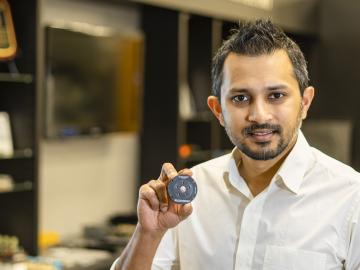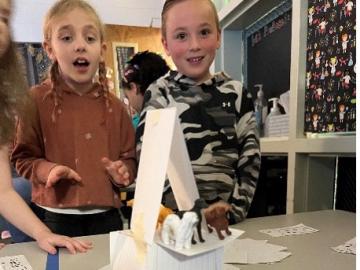
Filter News
Area of Research
- (-) Clean Energy (168)
- (-) National Security (45)
- Advanced Manufacturing (5)
- Biological Systems (1)
- Biology and Environment (102)
- Biology and Soft Matter (4)
- Building Technologies (2)
- Chemical and Engineering Materials (3)
- Chemistry and Physics at Interfaces (7)
- Climate and Environmental Systems (7)
- Computational Biology (1)
- Computational Chemistry (5)
- Computational Engineering (1)
- Computer Science (3)
- Data (1)
- Earth Sciences (1)
- Electricity and Smart Grid (1)
- Energy Frontier Research Centers (7)
- Fuel Cycle Science and Technology (2)
- Functional Materials for Energy (8)
- Fusion and Fission (32)
- Fusion Energy (7)
- Geographic Information Science and Technology (1)
- Isotopes (21)
- Materials (122)
- Materials for Computing (13)
- Materials Synthesis from Atoms to Systems (8)
- Materials Under Extremes (7)
- Neutron Data Analysis and Visualization (2)
- Neutron Science (72)
- Nuclear Science and Technology (27)
- Quantum Condensed Matter (3)
- Quantum information Science (4)
- Renewable Energy (2)
- Sensors and Controls (2)
- Supercomputing (153)
- Transportation Systems (4)
News Type
News Topics
- 3-D Printing/Advanced Manufacturing (23)
- Advanced Reactors (2)
- Artificial Intelligence (8)
- Big Data (4)
- Bioenergy (11)
- Biology (6)
- Biomedical (3)
- Biotechnology (2)
- Buildings (11)
- Chemical Sciences (3)
- Clean Water (3)
- Climate Change (11)
- Composites (2)
- Computer Science (15)
- Coronavirus (6)
- Cybersecurity (13)
- Decarbonization (16)
- Energy Storage (20)
- Environment (21)
- Fossil Energy (1)
- Grid (16)
- High-Performance Computing (5)
- Machine Learning (8)
- Materials (6)
- Materials Science (6)
- Mathematics (1)
- Mercury (1)
- Microelectronics (1)
- Microscopy (2)
- Nanotechnology (3)
- National Security (23)
- Net Zero (1)
- Neutron Science (4)
- Nuclear Energy (4)
- Partnerships (4)
- Polymers (1)
- Quantum Science (2)
- Security (8)
- Simulation (1)
- Space Exploration (1)
- Summit (3)
- Sustainable Energy (14)
- Transportation (17)
Media Contacts

Tristen Mullins enjoys the hidden side of computers. As a signals processing engineer for ORNL, she tries to uncover information hidden in components used on the nation’s power grid — information that may be susceptible to cyberattacks.

For more than 100 years, Magotteaux has provided grinding materials and castings for the mining, cement and aggregates industries. The company, based in Belgium, began its international expansion in 1968. Its second international plant has been a critical part of the Pulaski, Tennessee, economy since 1972.

Having passed the midpoint of his career, physicist Mali Balasubramanian was part of a tight-knit team at a premier research facility for X-ray spectroscopy. But then another position opened, at ORNL— one that would take him in a new direction.

Inspired by one of the mysteries of human perception, an ORNL researcher invented a new way to hide sensitive electric grid information from cyberattack: within a constantly changing color palette.

As a researcher in power electronics, Shajjad Chowdhury is focused on exceeding capacity. In a lab space at the National Transportation Research Center at ORNL, he’s developing a novel capacitor and inverter component that will shrink the size and reduce the cost of electric drive units. He sees this as a potential step to increase electric vehicle adoption in the United States.

On the grounds of the University of Maine’s Advanced Structures and Composites Center sits the nation’s first additively manufactured home made entirely from biobased materials - BioHome3D.

Using disinformation to create political instability and battlefield confusion dates back millennia. However, today’s disinformation actors use social media to amplify disinformation that users knowingly or, more often, unknowingly perpetuate. Such disinformation spreads quickly, threatening public health and safety. Indeed, the COVID-19 pandemic and recent global elections have given the world a front-row seat to this form of modern warfare.

Researchers at ORNL are helping modernize power management and enhance reliability in an increasingly complex electric grid.

Four nuclear nonproliferation staff members from the Department of Energy’s Oak Ridge National Laboratory were recognized as part of the 2021 Outstanding Security Team awarded by the Secretary of Energy for contributions to the Material Control and Accountability Technical Qualification Program Pilot.

Nine engineers from ORNL visited 10 elementary and middle school classrooms in three school districts during National Engineers Week, Feb. 21 to 24, 2023, describing and demonstrating the excitement of the engineering profession to more than 300 Tennessee students.


